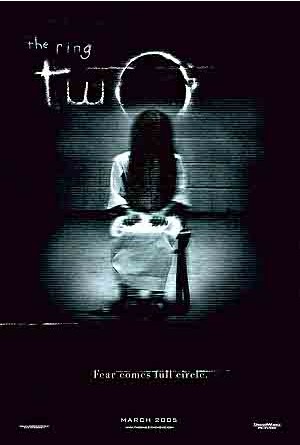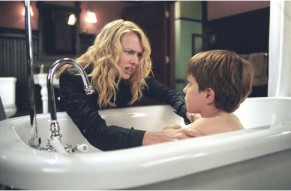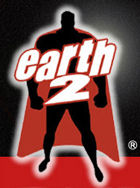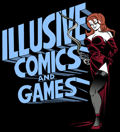|
The
Ring Two
The
Ring Two feels like it desperately needs to be The
Ring, too. Yet it lacks some of the fundamental
aspects that made Gore Verbinski’s remake of Hideo
Nakata’s Ringu so popular with American audiences
in the first place.
It’s
no doubt that Ringu is a superior film compared
to its stateside incarnation. The film had a depth to it
that brought out more than just the gimmick of victims being
found dead seven days after viewing the contents of an underground
style videotape. The film introduced hints of the arcane
ranging from psychic abilities to telekinetic powers all
at the disposal of a very fragile and unstable youth.
Sure,
there was a sprinkle of The Omen type vibe thrown
in for effect, but it worked. Verbinski’s adaptation
isolated the more commercial aspects of Ringu,
namely the videotape phenomena, and ran with them. Truth
be told, the concept is a publicity dream, and the team
over at Dreamworks had a field day.
Countering
this more vacant approach to the adaptation was Verbinski’s
touch as a music video director. Verbinski’s film
was steeped in cyclical symbology, taking the whole thing
a step further than its predecessor had. This is not to
overlook the manner in which the world of The Ring
glistened through the lens of cinematographer Bojan Bezelli,
whose framing and composition made the film look and feel
larger than life.
The
one constant thread stitching The Ring and The
Ring Two, production-wise, is screenwriter Ehren Kruger.
His barebones approach to adapting the first Ringu
may have worked largely because of what else was brought
to the table in other aspects of production. Who can forget
those wonderful nods to Alfred Hitchcock, and the infusion
of circles at every turn?
This
time out, Kruger is less successful, and the minimalist
approach is beginning to show signs of strain. After Verbinski
and a slew of other directors came and went, Dreamworks
finally turned their focus back to the man responsible for
the first incarnation of the Ringu novels on-screen,
Hideo Nakata. This is all well and good, but a return to
the roots of the series was definitely not the studios first
intent. Judging by the marketing campaign it would seem
that they wanted more Gore, and frankly it appears that
he wanted no more.
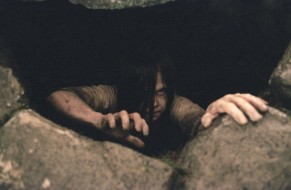 |
So with
Nakata on board we are delivered a sequel that does what
a sequel is expected to do, sputter and struggle its way
through a runtime that feels more like a prison sentence.
Reading a synopsis for Nakata’s Ringu 2,
for which he also shares a screenwriting credit, it would
seem that Kruger’s original approach to adaptation
was put into play with the sequel. Kruger takes one element
from the original sequel and expands it into a full length
feature, excising all else for sake of that good old Hollywood
feel.
What results
is a hollow film, devoid of any feeling, emotion, or scope.
Sure, we get to follow Rachel Keller (Naomi Watts) and her
son Aiden (David Dorfman) as they seek to restart their
lives in a quiet town outside of the big city. The problem
is, every other suggested plot thread from the first film,
however muted they may have been, is completely ignored
here. Instead of including the struggle by periphery characters
to understand the events transpiring, Kruger keeps the focus
solely on Rachel and Aiden, and the attempts by Samara (Kelly
Stables) to possess young Aiden.
The
“how’s and why’s” behind Samara’s
ability to haunt without even viewing the tape are strewn
together with little or no logic to them whatsoever. These
were plot points which were originally set up in Ringu,
then ignored in The Ring, and now rushed into acceptance.
This
is where the film falls flat on its face. You can’t
build up a set of rules in one film, and then completely
ignore those same rules without adequate explanation as
to why. In The Ring we learn about the cycle and
the sickly twisted manner in which the curse can be broken.
The conceit was simple; Samara, by way of the tape, forces
victims to choose between their own death and the selfishness
of condemning someone else to die in their place.
Yet
when Rachel investigates what appears to be a Samara-related
death, she somehow provides Samara access to her son Aiden,
whom Samara wishes to become. The problem is, the closing
sequence in The Ring already setup the necessary
connection with Aiden, and foreshadowed his eventual possession
adequately. Did Kruger simply forget the ending to his original
film?
Nakata’s
subdued approach to framing his sequences, via cinematographer
Gabriel Beristain, mixes perfectly with the original Ringu
series but sticks out against the polished high gloss imagery
of the original remake. Add to this a cameo by none other
than Sissy Spacek, her role retained to avoid spoilers,
feels completely wasted.
“Original
remake.” Perhaps this oxymoron is evidence as to where
the series took its first wrong turn. American films are
huge all over the world, without suffering extensive remakes.
It feels self-righteous and wrong to bury the filmic efforts
from places other than the U.S. in exchange for supercharged
re-do’s.
Rating:

|
